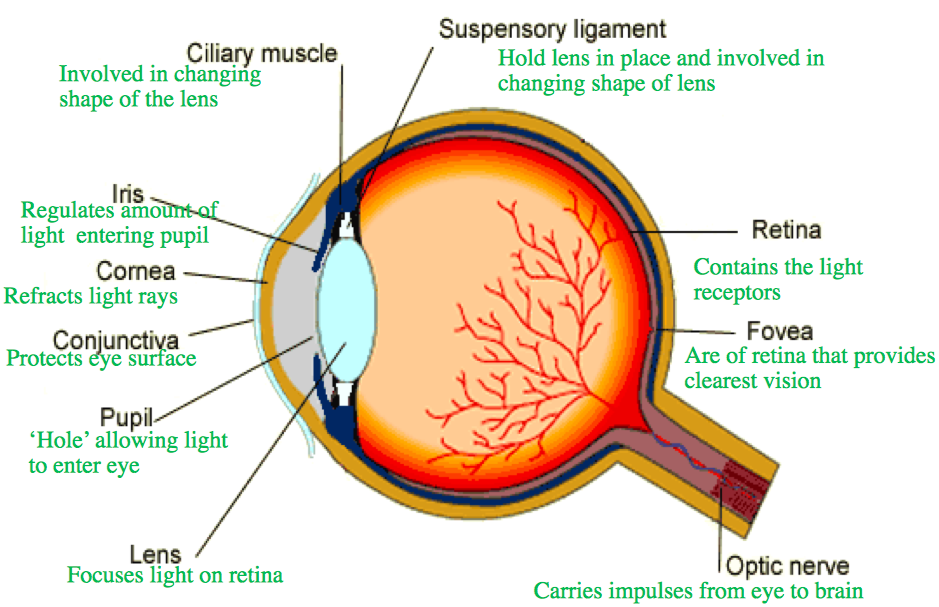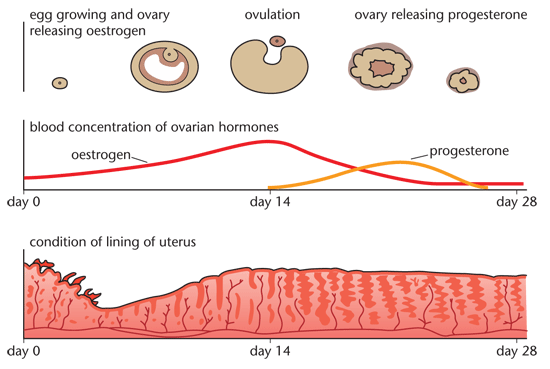Eyes and the Menstrual Cycle
Eye Structure & Function
The eye is a sense organ containing receptors sensitive to light intensity and colour. It has the ability to adapt to different light intensities and colour.
Accommodation is the process of changing the shape of the lens to focus on near or distant objects.
Light passes through the eyeball to the retina. There are two main types of light receptors called rods and cones. Rods are more sensitive to light than cones. This makes rods extremely useful for seeing in dim light. There are three different types of cone cells which is highly important as it produces colour vision.
When there’s dim light, more light is allowed to enter. The radial muscles contract so that the iris opens up, making the pupil larger, and allowing more light to enter.
When there’s bright light, less light is allowed to enter. The circular muscles contract in order to close up the iris, making the pupil smaller.
Eye Defects
| Type of Eye Defect | How it can be corrected |
| Cataracts (When the lens gets cloudy because of a build up of protein in the lens) | Removing the lens and replacing with plastic lens. |
| Long-Sightedness - hyperopia (The individual cannot focus on near objects as the eye may be too short, or they have a loss of elasticity in their lens. The rays of light do not focus on the retina) | Place a convex lens in front of the eye Hard and soft contact lenses, laser surgery to change the shape of the cornea and a replacement lens in the eye. |
| Short-Sightedness - myopia (The individual will not be able to focus on distant objects as their eyeball is elongated, or their lens is too thick and curved. The rays of light do not focus on the retina) | Place a concave lens in front of the eye Hard and soft contact lenses, laser surgery to change the shape of the cornea and a replacement lens in the eye. |
Eye Focus
To focus on a near object:
- The ciliary muscles contract
- The suspensory ligaments loosen
- The lens is then thicker and refracts light rays strongly.
To focus on a distant object:
- The ciliary muscles relax
- The suspensory ligaments are pulled tight
- The lens is then pulled thin and only slightly refracts light rays.
Menstrual Cycle
- During puberty reproductive hormones cause secondary sex characteristics to develop.
- Oestrogen is the main female reproductive hormone produced in the ovary. At puberty eggs begin to mature and one is released approximately every 28 days. This is called ovulation.
- Testosterone is the main male reproductive hormone produced by the testes and it stimulates sperm production.
- Several hormones are involved in the menstrual cycle of a woman.
- The menstrual cycle is a cycle of physiological changes that take place in women only a monthly basis. It is more commonly known as a period.
Key Stages
- High levels of FSH will stimulate the egg to be ripe in the ovaries
- Oestrogen then stimulates the womb lining to build up so that the woman can be prepared if an embryo does grow inside of her.
- At around day 14, LH stimulates the release of the egg.
- Progesterone would maintain the uterus lining.
- Low levels of oestrogen and progesterone will cause the uterus lining to break down.
- As a result, blood and tissue will be loss - this is called menstruation.
Hormone Interaction
The hormones interact during the menstrual cycle in order for the cycle to take place.
- High levels of FSH stimulates the ovaries to produce oestrogen.
- When oestrogen is produced, it stops FSH production.
- This then causes LH to be produced - and this leads to ovulation on day 14.
- Meanwhile, progesterone levels will increase as it is created by the follicle.
- After day 14, progesterone continues to be released as it stops the lining from breaking down, as well as prevent another egg from being released.
- If a woman is not pregnant, the egg will degenerate with the lining of the womb. Progesterone levels will then drop and menstruation occurs.
- This cycle then starts again!
- What do high levels of FSH lead to?
- Your answer should include: Stimulates / Ovaries / Produce / Oestrogen
- What is accommodation?
- Your answer should include: Process / Changing / Shape / Focus / Near / Distant / Object / Objects
Explanation: Accommodation is the process of changing the shape of the lens to focus on near or distant objects.

